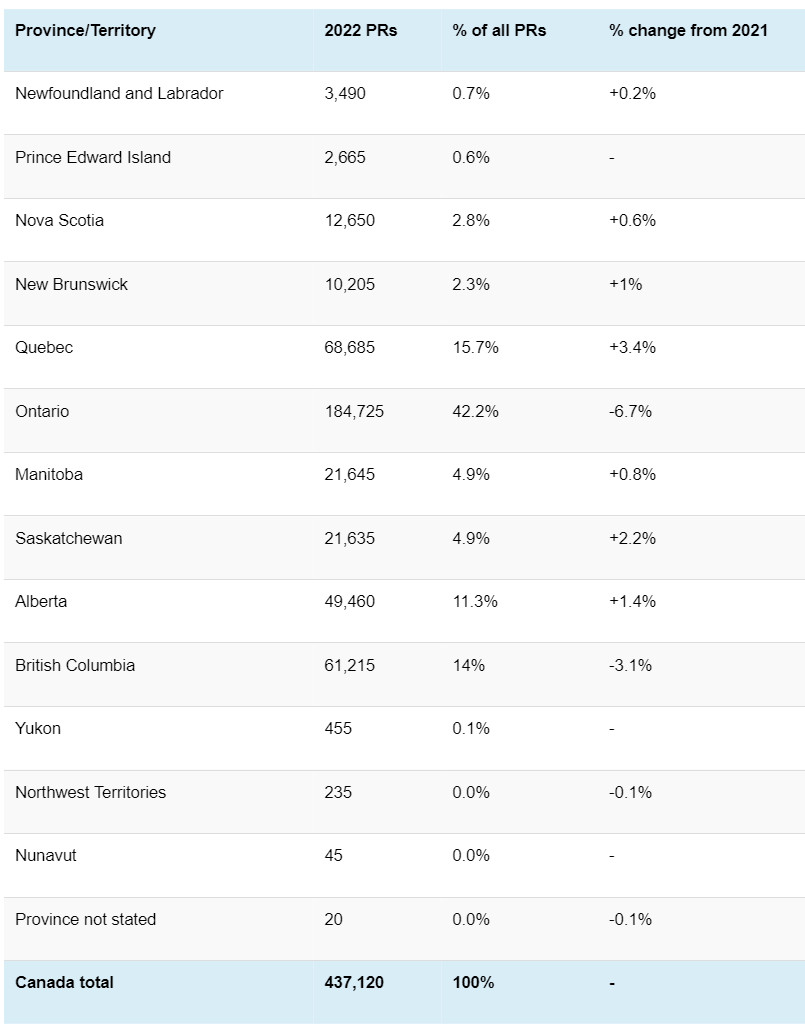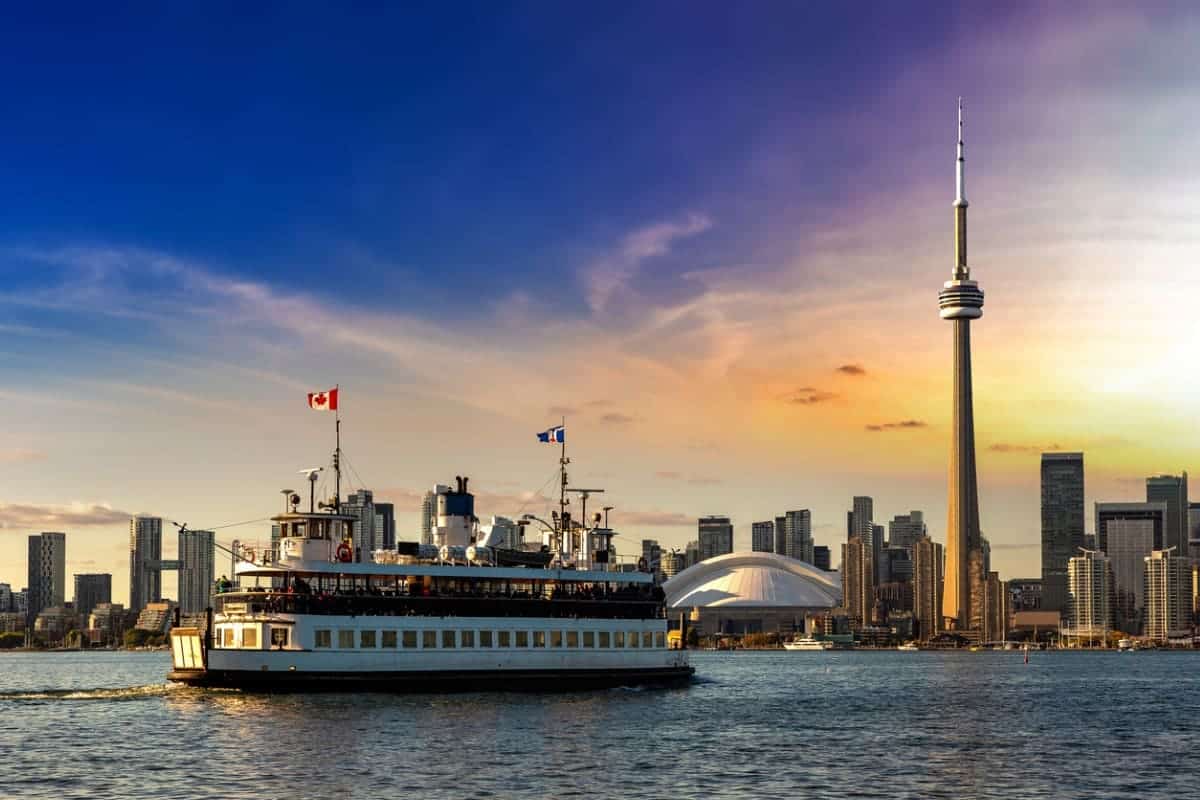Since the pandemic-related decline in 2020, immigration to Canada has increased to a new high, making this the nation’s second straight year of record-breaking immigration.
In 2022, Canada received 437,120 PRs from all over the world.
This estimate reflects an approximately 8% increase over the total number of PRs arrived in 2021, according to data released by Immigration, Refugees and Citizenship Canada (IRCC).
In accordance with the 2022-2024 Immigration Levels Plan, Canada has also surpassed its declared immigration objective for the second consecutive year, surpassing the 2022 target number (431,645) by more than 5,000 persons. In addition, last year was only the third time in Canadian history—after 1913 and 2021—that this nation welcomed more than 400,000 immigrants in a single year.
Due to COVID-19 travel restrictions, Canada only accepted 184,000 new Permanent Residents in 2020.
Programmes for economic immigration became once more Canada’s top priority and main source of immigrants in 2022. In actuality, 58.5% of all new Canadian PRs over the course of the year came via economic immigration, which includes worker programmes, company programmes, the Provincial Nominee Programme (PNP), and paths from temporary residence to permanent resident.
For 2022, a monthly breakdown of new arrivals as permanent residents of Canada
At least 23,000 new PRs came to Canada in each of the 12 months of 2022. The exact number of new Canadian PRs who entered Canada each month last year is listed below.
- January: 35,450
- February: 37,360
- March: 40,985
- April: 36,365
- May: 37,985
- June: 43,940
- July: 43,330
- August: 34,135
- September: 44,645
- October: 33,625
- November: 25,970
- December: 23,340
Canadian permanent resident arrivals by immigration category in 2022
Through economic-class immigration programmes, 256,000 new PRs entered Canada in 2022. In the 2022–2024 Immigration Levels Plan, which was unveiled in mid–February of last year, the country had set a target of 14,150 economic immigrants; this represents an increase of +5.8%.
In 2022, 97,165 new permanent residents entered Canada under programmes for the family class of immigrants. The target of 105,000 individuals put forth in the 2022–2024 Immigration Levels Plan was not met by this number, which represents 22.2% of all newly arrived Canadian PRs.
The IRCC desired that in 2022, this category would represent slightly over 24% of all freshly landed PRs.
The year 2022 saw a total of 75,330 “resettled refugees and protected persons” enter Canada, rounding up the main immigration categories. 17.2% of all new permanent residents to Canada were refugees and protected persons. Despite the fact that Canada was able to accept more immigrants this year than the year before (60,115 in 2021), IRCC only narrowly met the 76,565 objective established for this immigration class (17.7% of all Canadian PRs).
The IRCC identified the remaining 8,500 new Canadian PRs as entering Canada under “All Other Immigration.”
In 2022, the majority of new Canadian PRs were from Afghanistan, China, and India.
The top source nations for the class of new Canadian permanent residents arriving in 2022 have changed slightly from the previous year, with Afghanistan and Syria replacing Brazil and South Korea in the top 10.
In 2022, China will once again take second place after India as the top country from which Canadians immigrate. The proportion of immigrants from these two nations, which was 32% and 8%, respectively, last year, has fallen in contrast to 2021.
According to each immigrant’s country of citizenship, the following 10 nations were Canada’s main immigration sources in 2022. Each country’s immigration numbers and the proportion of its entire PR population that immigrated from that nation will be listed.
- India (118, 095 immigrants) – 27%
- China (31,815 immigrants) – 7.2%
- Afghanistan (23,735 immigrants) – 5.4%
- Nigeria (22,085 immigrants) – 5.05%
- Philippines (22,070 immigrants) – 5.04%
- France (14,145 immigrants) – 3.2%
- Pakistan (11,585 immigrants) – 2.6%
- Iran (11,105 immigrants) – 2.5%
- United States of America (10,400 immigrants) – 2.3%
- Syria (8,500 immigrants) – 1.9%
Top immigration locations for permanent residents in 2022 included Quebec and Ontario
Although Ontario continued to be the most popular immigration destination for PRs in Canada in 2022, Quebec surpassed British Columbia as their second most popular initial settlement place.
While over 49% of new PRs settled across the province in 2021, just 42.2% of them chose Ontario as their initial location in 2022. This may be a result of Canada’s efforts to spread the advantages of immigration more widely around the nation, which are being successful as the PNP gradually begins to predominate over Express Entry.
Quebec, which welcomed 68,685 immigrants in 2022, came in second. This number represents around 15.7% of all incoming immigrants, an increase from slightly more than 12% in 2021.
Lastly, British Columbia welcomed 14% of immigrants to Canada in 2022, a decrease of around three percent from the previous year. Only Alberta received more than 10% of all landed immigrants in 2022; the province received a total of 49,460 immigrants throughout the course of the year (11.3%).
The table below shows the number of landed PRs in each province and territory of Canada for 2022 (along with the percentage share), as well as the % change in landed PRs for that region from 2021.


